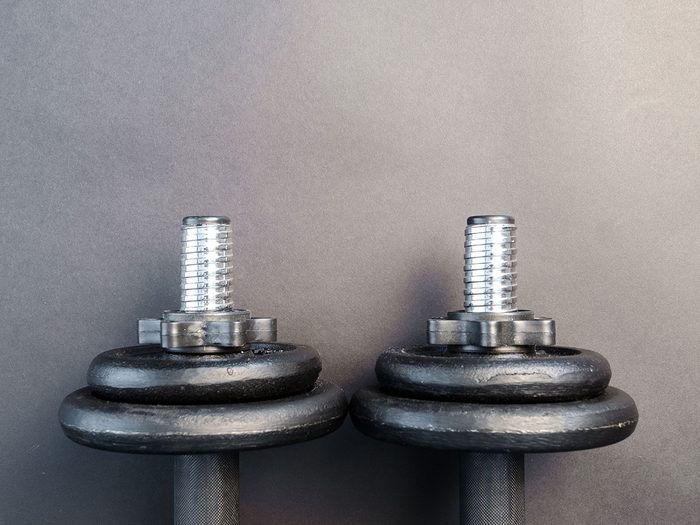
For so long the prevailing narrative around exercise was about losing weight, but with many new strength training classes and HIIT workout options, that story has shifted—at least for some—to be about getting strong.
What you might not know is that strength training offers more than stronger muscles and a toned body. “It can improve bone health, prevent bone density loss, and improve muscle mass,” says Céleste Corkery, a physiotherapist at Women’s College Hospital. “It can even help prevent some chronic diseases like heart disease, diabetes, and metabolic diseases.”
However, strength training often gets a bad rap thanks to its bodybuilder reputation (not everyone wants to look like a bodybuilder) and the possibility of injury, which seems more ominous with the addition or barbells and kettlebells. So, we spoke to personal trainer and the owner of La Femme Strong gym in Toronto, Sydney Dunitz, about how to get the most out of your strength training routine. Our main takeaway? Although form is important, a strength training workout will only do you good if it’s safe. “It’s not really about doing things correctly versus incorrectly—there are so many different ways to do a move,” she says. “It’s actually safe versus unsafe execution.”
Here are the six mistakes you may be making when strength training and how to do the common moves safely. These tips will help ensure you’re actually working your butt off.
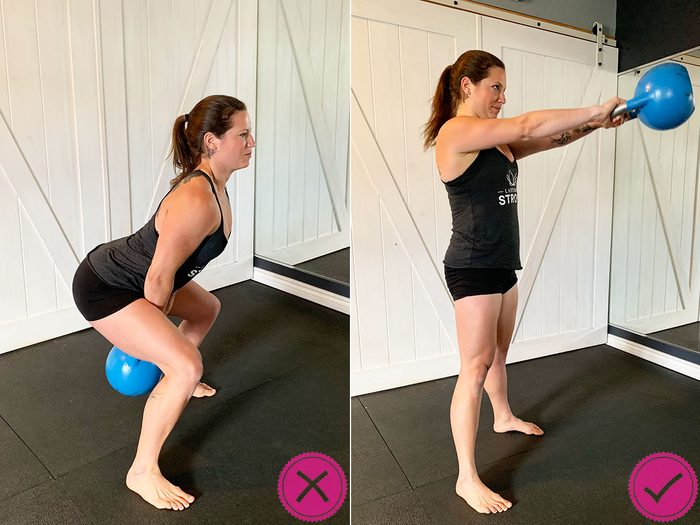
The Move: Kettlebell Swing
Kettlebells are one of Dunitz’s favourite tools for a strength workout. But, “the kettlebell swing gets a really bad rap for damaging people’s backs,” she notes. It’s a move that should be focused on your glutes and hamstrings, but many people mistake it for an arm workout. You should be hoisting or swinging the kettlebell up by using your lower body to propel the kettlebell forward. “There’s no way to cheat this move in a safe way,” says Dunitz, which is perhaps why it’s one that people shy away from.
The Mistake: “The common misconception with this move is that it’s a squat-based movement and that you need to swing the kettlebell as high as you can,” says Dunitz. Another big mistake is arching your back.
The Fix: Instead of squatting, you should be pushing your butt back—not down—and keep your weight in your heels. “You always want to make sure your abs are really engaged, which keeps your body in alignment,” says Dunitz. “When you come up, you want to squeeze your butt as much as you can—if you’re not squeezing your butt you’re likely using your arms to swing the kettlebell, which defeats the purpose of the move and can be dangerous.” Forget about how the move looks and how high the kettlebell is going (it shouldn’t go higher than your shoulders). Focus on whether or not your butt is working hard. (Also, here’s how you can burn fat with a kettlebell.)
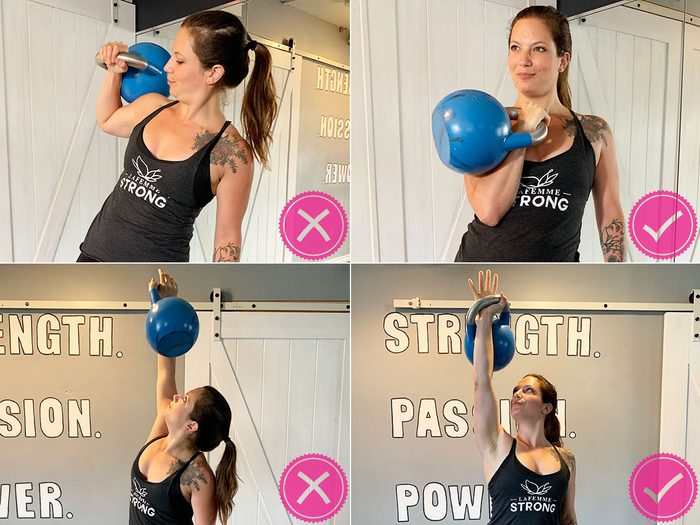
The Move: Kettlebell Clean and Press
“The one thing I really enjoy about the clean and press is that it’s a whole-body movement,” says Dunitz. If you’re familiar with the typical clean and press (often done with a bar), then this will be familiar to you. It’s a move in two parts, the first being “the clean” (hoisting your weight up, to about chin height) and “the press” (which pushes the weight above your head). (Also, here’s how to use a kettlebell for abs.)
The Mistake: The main reason people avoid this move is fear. “Many people are afraid to hold the kettlebell close to their body, and when people bring it up, they swing it away from themselves and end up twisting their body,” says Dunitz. For the press portion, people worry about hitting themselves in the face and end up holding the kettlebell in a position that can make it easy for them to dislocate the shoulder.
The Fix: For the clean, “the kettlebell should be right underneath your chin,” says Dunitz. Make sure you’re not balancing it on your shoulder, with your elbow twisted out. For the press, remember that form is always important, but especially important when you hoist anything heavy above your head. Avoid twisting the torso and keep the kettlebell close to your body so the momentum doesn’t throw off your stability. Use your legs to help you press up, instead of trying to swing that kettlebell up high.
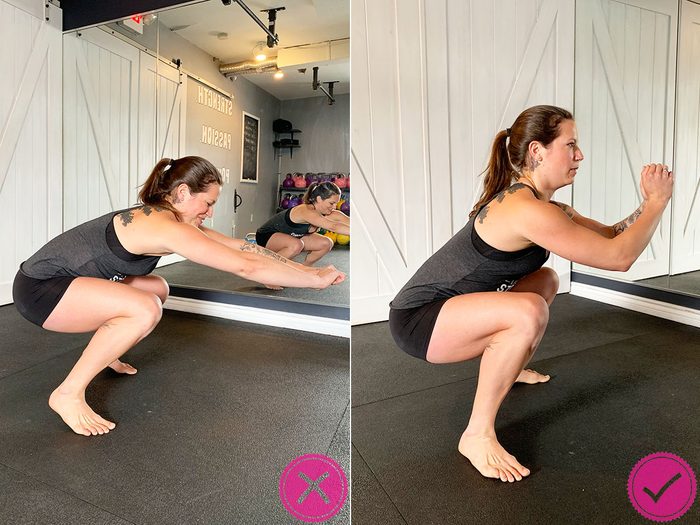
The Move: Squats
According to Dunitz, there are many different types of squats, and how you do one largely depends on your goal. Most people focus on glutes and hamstrings. (Do you know how many squats it takes to see results?)
The Mistake: “Because most people are quad dominant, when you go down, what usually happens is your knees come into the middle,” says Dunitz, noting that your body usually wants to do what’s easiest. Another issue? Hunched shoulders. “As soon as you round your shoulder forward, you’re going to hurt your lower back and throw the weight forward, in front of your foot, which can put a lot of pressure on your knees,” she says.
The Fix: If you’re doing squats to focus on glutes and hamstrings, you want to keep your knees rotated out. A good way to ensure you’re doing this is to rotate your feet slightly out and keep your knees above your toes. This helps to ensure that your quads aren’t doing all the heavy lifting that you want your butt to be doing. Keep shoulders back and chest proud to avoid hurting your lower back or putting undue pressure on your knees.
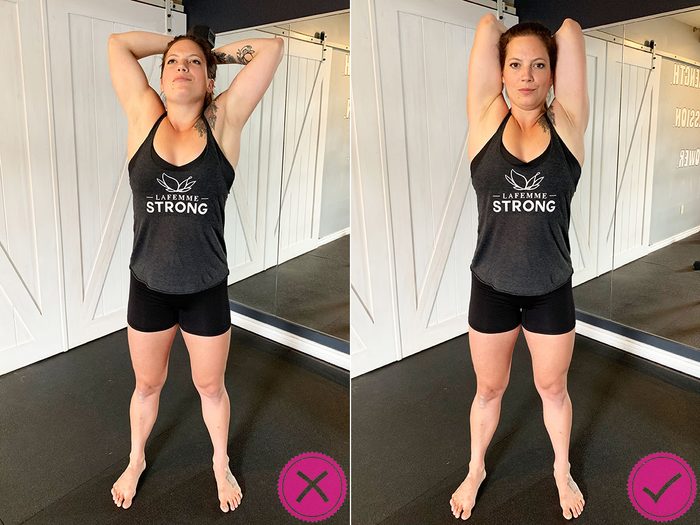
The Move: Tricep Extensions
A tricep extension is when you hold a single weight above your head and bend your arms to lower it behind you. It’s one of the best arm workouts—when done correctly. When done poorly, it doesn’t work out arms at all.
The Mistake: “One thing people do wrong is move their shoulders up towards their ears,” says Dunitz. “Everyone carries so much tension in their traps on any given day, there’s no need to add more.” The other mistake is having wide elbows, which doesn’t make the move as effective.
The Fix: “It’s all about your elbow position,” says Dunitz. Keep elbows beside your ears so you target the triceps effectively. Release tension in your shoulders by keeping them away from your ears.
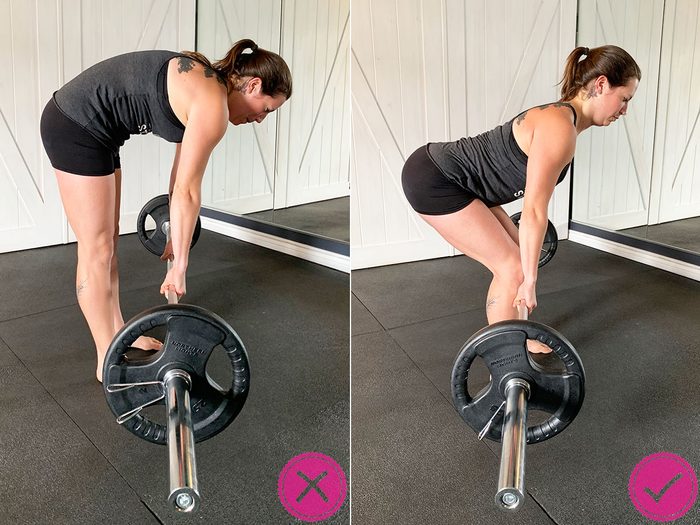
The Move: Deadlift
Just like squats, there are multiple correct ways to do a deadlift. Dunitz is particularly fond of the Romanian deadlift, which is considered to be more glut- and hamstring-focused than a conventional or sumo deadlift. The deadlift requires the lifting and lowering of a bar (often with weights on either end).
The Mistake: “The first thing people do wrong is round their backs,” says Dunitz. Because people often use heavier weights with a deadlift than they use in other weight-focused workouts, the possibility of injury can be likely, especially with poor form. “The risk factor is huge if you don’t know what you’re doing,” says Dunitz. “If you’re new to deadlifting, start light, and ask for help.”
The Fix: When you pick up the bar, get a good grip and dig your heels into the ground. Straighten your back and keep your core stacked to engage the abs. “I tell people to arch their backs slightly—just to throw the weight back,” says Dunitz. “You’ll have such a heavy weight in front that your shoulders will want to bend forward.” For the lifts, remember to push your weight back, bend your knees, and push your butt backwards, instead of dropping it down. The move isn’t about the bar, says Dunitz. The bar is just weighing the move down, providing resistance. Focus on the movement of your butt pushing back and then squeezing up to standing.
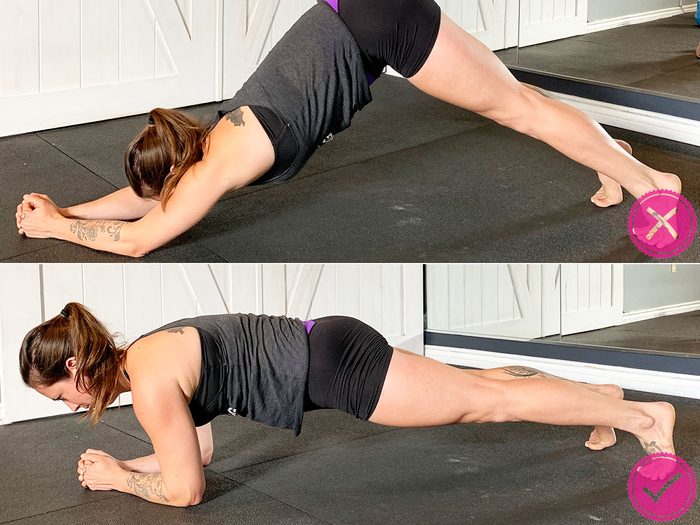
The Move: The Plank
“The point of a plank is to work your abs and stabilize muscles,” says Dunitz. This requires you to brace your weight using your arms and feet. Many people aren’t good at this move because most people don’t have super strong cores, and hold a plank correctly is difficult.
The Mistake: The mistake people make is breaking the line of the plank—think arms out and butt up. This places the work on the shoulders, instead of the abs.
The Fix: “Your hands and elbows should be beneath your shoulders and your butt should be down,” says Dunitz. Sounds simple enough, but it’s a hard move to hold without cheating it. (So, it can be a good idea to find a new ab move.) “If you’re someone who isn’t going to work to perfect a plank, but you want to work those muscles, you can do an inverted plank,” says Dunitz. “There’s no way you won’t use your abs with that move!”
Next, learn about the mistakes you’re making in spin class.
